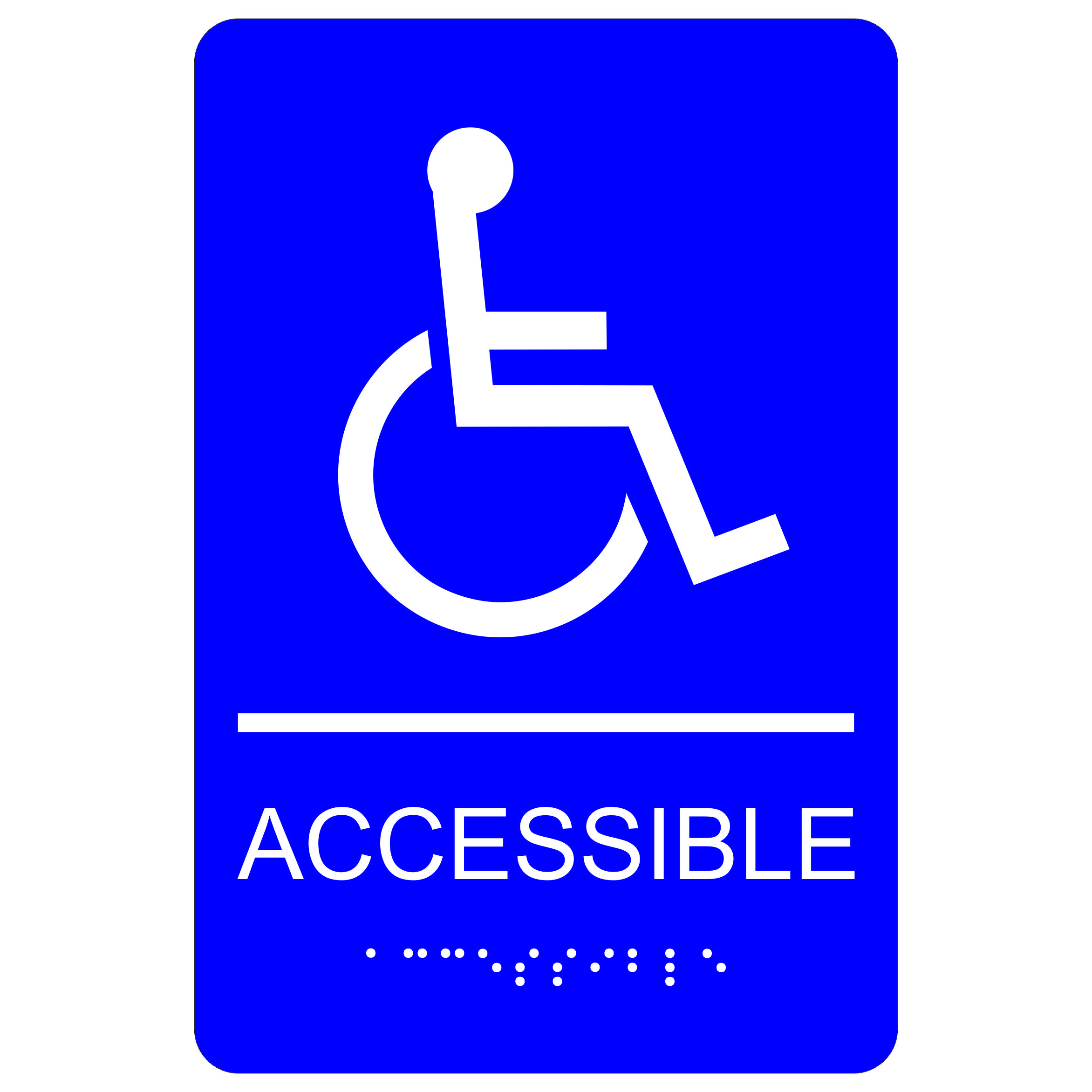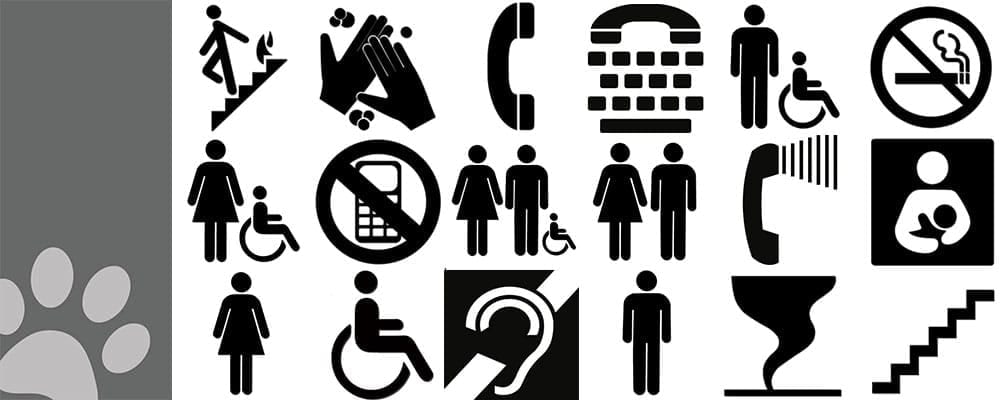Discovering the Trick Attributes of ADA Indicators for Enhanced Ease Of Access
In the realm of availability, ADA indicators function as quiet yet effective allies, ensuring that areas are comprehensive and navigable for individuals with disabilities. By integrating Braille and responsive aspects, these signs break barriers for the visually impaired, while high-contrast color design and understandable font styles deal with diverse aesthetic requirements. Moreover, their strategic positioning is not approximate but instead a computed effort to assist in smooth navigation. Yet, past these attributes lies a much deeper narrative about the advancement of inclusivity and the recurring commitment to creating equitable areas. What a lot more could these indications indicate in our search of universal ease of access?
Value of ADA Conformity
Guaranteeing compliance with the Americans with Disabilities Act (ADA) is vital for fostering inclusivity and equal gain access to in public areas and workplaces. The ADA, passed in 1990, mandates that all public facilities, employers, and transportation solutions fit people with handicaps, ensuring they take pleasure in the same legal rights and possibilities as others. Conformity with ADA criteria not just satisfies lawful responsibilities however likewise boosts an organization's track record by showing its dedication to diversity and inclusivity.
One of the essential aspects of ADA compliance is the implementation of obtainable signs. ADA indications are designed to ensure that individuals with handicaps can conveniently navigate via structures and rooms.
Moreover, sticking to ADA regulations can minimize the danger of legal repercussions and prospective fines. Organizations that fail to follow ADA guidelines might deal with charges or lawsuits, which can be both economically burdensome and destructive to their public photo. Therefore, ADA conformity is integral to promoting an equitable atmosphere for every person.
Braille and Tactile Elements
The unification of Braille and responsive elements into ADA signage symbolizes the concepts of accessibility and inclusivity. These functions are critical for individuals that are blind or aesthetically impaired, allowing them to navigate public areas with higher independence and confidence. Braille, a responsive writing system, is essential in supplying created info in a format that can be conveniently regarded through touch. It is normally put underneath the equivalent text on signage to make certain that individuals can access the info without aesthetic support.
Responsive aspects prolong beyond Braille and include elevated icons and personalities. These components are developed to be discernible by touch, enabling people to identify area numbers, toilets, departures, and other critical areas. The ADA establishes specific guidelines relating to the size, spacing, and positioning of these responsive aspects to optimize readability and make certain uniformity across various environments.

High-Contrast Color Schemes
High-contrast color pattern play a pivotal duty in improving the presence and readability of ADA signage for people with visual problems. These schemes are necessary as they make the most of the distinction in light reflectance in between text and history, guaranteeing that indicators are quickly discernible, also from a distance. The Americans with Disabilities Act (ADA) mandates using particular shade contrasts to accommodate those with restricted vision, making it an important facet of compliance.
The efficiency of high-contrast colors hinges on their capacity to stick out in numerous lighting problems, including poorly lit environments and areas with glare. Commonly, dark text on a light background or light message on a dark background is utilized to attain optimal contrast. For example, black text on a yellow or white background offers a plain visual difference that assists additional reading in fast recognition and comprehension.

Legible Fonts and Text Size
When thinking about the layout of ADA signs, the choice of clear font styles and proper message dimension can not be overstated. These aspects are crucial for guaranteeing that indications are easily accessible to individuals with visual disabilities. The Americans with Disabilities Act (ADA) mandates that font styles need to be not italic and sans-serif, oblique, manuscript, very decorative, or of uncommon type. These requirements help make sure that the message is quickly understandable from a distance and that the characters are distinguishable to varied target markets.
According to ADA standards, the minimal text height should be 5/8 inch, and it must enhance proportionally with watching distance. Uniformity in message size adds to a cohesive aesthetic experience, aiding people in navigating settings effectively.
Furthermore, spacing between letters and lines is important to legibility. Adequate spacing stops characters from appearing crowded, boosting readability. By adhering to these criteria, designers can dramatically improve access, guaranteeing that signs offers its intended purpose for all people, no matter their visual capacities.
Effective Placement Approaches
Strategic placement of ADA signage is essential for optimizing accessibility and making sure conformity with legal requirements. Appropriately positioned indications lead people with disabilities efficiently, assisting in navigating in public rooms. Key factors to consider include presence, closeness, and elevation. ADA standards specify that signs ought to be installed at a height between 48 to 60 inches from the ground to ensure they are within the line of sight for both standing and seated individuals. This basic elevation variety is important for inclusivity, making it possible for mobility device customers and people of differing elevations to gain access to details easily.
In addition, indications have to be put adjacent to the lock side of doors to enable easy recognition before access. Consistency in indicator placement throughout a facility boosts predictability, decreasing complication and improving total user experience.

Conclusion
ADA indications play an essential function in advertising accessibility by incorporating functions that attend to the requirements of individuals with handicaps. Integrating Braille and responsive aspects makes certain vital details is available to the visually damaged, while high-contrast color design and clear sans-serif typefaces boost visibility across different lights problems. Efficient positioning approaches, such as appropriate mounting heights and critical locations, even more help with navigation. These elements collectively foster an inclusive atmosphere, highlighting the check over here value of ADA conformity in making certain equivalent accessibility for all.
In the world of access, ADA indicators serve as silent yet powerful allies, making certain that rooms are inclusive and accessible for people with specials needs. The ADA, passed in 1990, mandates that all public facilities, companies, and transport services accommodate people with specials needs, ensuring they enjoy the exact same legal rights and possibilities as others. ADA Signs. ADA indicators are designed to ensure that people with impairments can conveniently browse through rooms and structures. ADA guidelines stipulate that indicators ought to be placed at a height in between 48 to 60 inches from the ground to guarantee they are find more information within the line of sight for both standing and seated people.ADA indications play a vital duty in promoting ease of access by integrating attributes that deal with the demands of individuals with handicaps
Comments on “The Duty of ADA Signs in Following Access Standards”